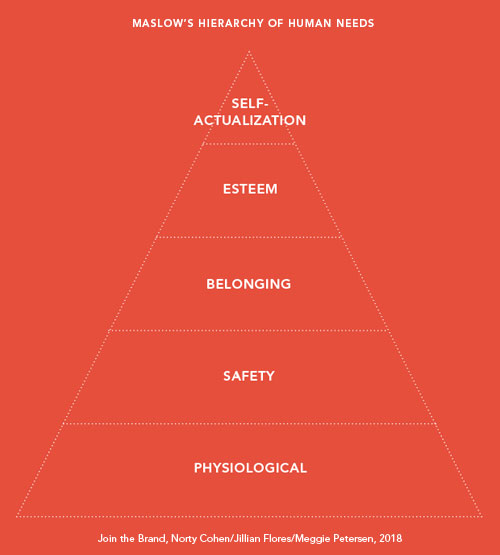Looking back at 2018, there’s one competitor we underestimated this year.
It’s slowly draining the attention of every human on the planet.
It plays into almost all human needs — as they are defined by the Maslow Hierarchy.
It’s the rectangular status-seeking device in your hands. That’s right. It’s your smartphone.
Maslow’s needs start with the basics. Starting at the bottom of the pyramid, we all need food and water. Then safety. Next up is belonging, then esteem, then self-actualization.

The hierarchy was first introduced in a research paper by the psychologist Abraham Maslow in 1943. He had no idea that 64 years later, the invention of the smartphone would supercharge the famous pyramid.
Here’s why: We now check our phones the equivalent of one day a week, and 20 percent of adults spend 40 hours a week on it. The stats suggest we check our phones 80 to 150 times per day, on average.
That’s not new news after a decade of the smartphone’s existence, but one of today’s biggest marketing mistakes is underestimating what people are doing with those phone checks.
With Maslow’s guidance, it’s clear we are reinforcing our need to belong, checking our status, and ultimately building our esteem toward self-actualization.
So, what can brand marketers do about it?
Marketers Marketing to Marketers
This amplified the need to belong and check status has turned into hundreds of millions of personal advertising campaigns, all competing against brands for attention.
It is much more likely for people to adopt a brand based on friends and family sharing content than TV, Facebook, and YouTube advertising combined.
They’re not just looking at friends and family content all day. They’re making it. Millennials might spend two hours a day creating and posting. Plus, there’s important time spent checking the metrics and seeing who liked their posts.
The sheer weight of personal messages from friends and family minimizes the “cut-through” ability of advertiser-paid messaging. Literally, everyone is building status in real time, 24/7, with the instant gratification of shared photos and videos traveling at lightning-fast smartphone processing speed.
If you multiply personal posts by the total number of friends on everyone’s contact list, you have a lot of ground to cover to join the conversation. The world of organic reach is a nonfactor for brands, leaving engagement as the affordable metric of choice.
Going forward, your job as a marketer is not just to engage one audience group. You also need to engage friends of friends.
That means, stop focusing on just your target market. It’s your target’s target you need to reach.
So, what to do differently in 2019?
Create a Brand Community
Fans sometimes love the identity of a brand so much they brand themselves with it. Why is this important? Because whatever they’re doing ultimately will be the formula for building organic participation. When there’s enough participation, a community forms around the brand. Once that happens, creating friends of friends is no longer insurmountable.
Logically, if people are talking positively about your brand to reinforce their status, the marketer-to-buyer barrier is broken. You are one of them. In the friend set.
“Superfans” are those who feel a true sense of identity in their chosen brand relationships and are able to say that their friends would agree. Superfans are more likely to share content and brand themselves with the identity of their favorite brands than other fans. They “mentally smile” when they see others using their preferred brands.
Brands have achieved success in cultivating this type of following by following a formula:
- Ignite the Fire
- Fuel the Flame
- Pass the Torch
This is the path for competitive brands going forward. The cost of finding that moment in the world of “friend posts and shares” as an outsider is a price tag that few can afford.
Ignite the Fire
Brands that have a unique story can easily get past “advertiser” and move to “friend” status. What’s true about your story? What’s likable about it? Can you tell it in an inviting way?
Fat Face is a European clothing chain that got its name when its founders didn’t want to get off the French mountain they were skiing on. They were from the UK and the name of their favorite slope translated to “Fat Face” in English. They started selling “Fat Face” t-shirts out of their VW van. Those original shirts amplified into a line of clothing and stores and a style all their own. It’s a real story. And people want to brand themselves with it.
Organic Valley calls itself the “un-corporation.” It started as a group of independent farmers — and though the farmers themselves haven’t changed, they now bring more than US$1 billion worth of dairy goods to stores throughout the U.S. They have videos with their CEO barefoot, and they show an organization chart with him at the bottom. Packages with cows kissing farmers just make it a great brand and a believable story.
Fuel the Flame
Driving involvement in your brand can take many forms — from unique lingo and secret menus to cocreation concepts and gaming. The point is to give the consumer a connection point. Xbox allows users to custom-design their own game controllers. It’s personal. It’s virtual. And it’s tactile. All in one idea.
Starbucks has a simple form on its website entitled “My Starbucks Idea.” This began in 2013 — and the company has created 277 products from more than 150,000 suggestions, including free WiFi, splash sticks, cake pops, and pumpkin-spiced lattes.
Designing shoes, playing games, and interacting all lead to real conversations and entertainment and allow brands to meet consumers where they already live and play. Joining them before they join you is the groundwork that all marketers need to do.
Pass the Torch
Appointing loyalists to tell your story builds reputations organically, as long as the tone is sincere and the rewards are fulfilling.
Southern Tide is a clothing line that targets the college market. It does so by recruiting college reps and benchmarking their status with trendsetters who are selling their credibility every day. For some, getting chosen to represent the brand has as much status as getting into the school of choice.
TheSkimm is a daily newsletter targeting a female audience. Advertisers can participate — not by submitting ads, but by providing rewards for Skimmbassadors. How to become one? Get 10 of your friends to sign up for the service. There are now 12,000 of them and more than 5 million readers.
Taco Bell created a wedding chapel in Las Vegas. The package includes memorable (and shareable) moments and a taco 12-pack for guests. It’s joining people where they are and having fun with them. By the way, there’s a four-hour notice required in case you get the fever.
Consider the economics of owning versus renting. Much like any other equity, it’s better to own. Own your data. Own your audience. Don’t be beholden to social networks. Email and e-commerce are far more affordable than paying for reach.
So, the lesson for 2019 is to move past just asking consumers to buy the brand. Instead, ask them to join the brand.













































True, Thanks for this piece